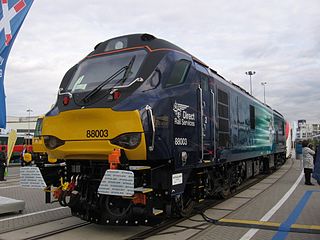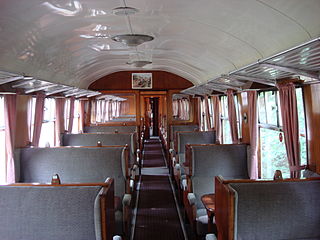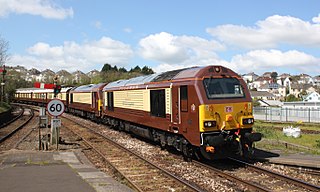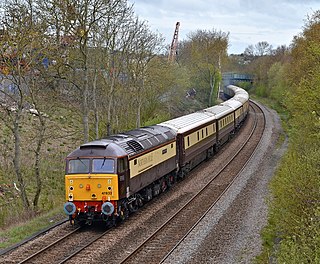
The Southern Railway (SR), sometimes shortened to 'Southern', was a British railway company established in the 1923 Grouping. It linked London with the Channel ports, South West England, South coast resorts and Kent. The railway was formed by the amalgamation of several smaller railway companies, the largest of which were the London and South Western Railway (LSWR), the London, Brighton and South Coast Railway (LB&SCR) and the South Eastern and Chatham Railway (SE&CR). The construction of what was to become the Southern Railway began in 1838 with the opening of the London and Southampton Railway, which was renamed the London & South Western Railway.

Direct Rail Services (DRS) is a rail freight company in Great Britain, and is one of the publicly owned railway companies in the United Kingdom.

The InterCity 125 (originally Inter-City 125) or High Speed Train (HST) is a diesel-powered high-speed passenger train built by British Rail Engineering Limited between 1975 and 1982. A total of 95 sets were produced, each comprising two Class 43 power cars, one at each end, and a rake of seven or eight Mark 3 coaches. The name is derived from its top operational speed of 125 mph (201 km/h). At times, the sets have been classified as British Rail Classes 253, 254 and 255.

Metro-Cammell, formally the Metropolitan Cammell Carriage and Wagon Company (MCCW), was an English manufacturer of railway carriages, locomotives and railway wagons, based in Saltley, and subsequently Washwood Heath, in Birmingham. The company was purchased by GEC Alsthom in May 1989; the Washwood Heath factory closed in 2005 and was demolished in early 2019.

InterCity was introduced by British Rail in 1966 as a brand-name for its long-haul express passenger services.

Riviera Trains Limited is a railway spot-hire company based at Burton-on-Trent and Eastleigh in England.

The Blue Pullmans were luxury trains used from 1960 to 1973 by British Rail. They were the first Pullman diesel multiple units, incorporating several novel features.

British Railways Mark 1 is the family designation for the first standardised designs of railway carriages built by British Railways (BR) from 1951 until 1974, now used only for charter services on the main lines or on preserved railways.

The Mark 2 family of railway carriages are British Rail's second design of carriages. They were built by British Rail workshops between 1964 and 1975. They were of steel construction.

The British Rail Mark 3 is a type of passenger carriage developed in response to growing competition from airlines and the car in the 1970s. A variant of the Mark 3 became the rolling stock for the High Speed Train (HST).
Hertfordshire Rail Tours was a company that operated charter trains in the United Kingdom. Founded in Hertfordshire by John Farrow, most of its trains started from London Terminals. The company was purchased by FM Rail in September 2005. FM Rail went into liquidation in December 2006, and the Hertfordshire Rail Tours business passed to Victa Westlink Rail, a joint venture between Victa Railfreight and Westlink.
The name Queen of Scots was originally given to an LNER/BR Pullman train which ran from London King's Cross to Glasgow Queen Street via Leeds Central, Harrogate, Newcastle and Edinburgh Waverley. Later the Queen of Scots was a luxury touring train that ran exclusive tours around Scotland's scenic countryside. The train was mostly aimed at American tourists. The train ran from 1985 to 1989 as the Royal Scotsman and in 1990 as The Queen of Scots.

The Night Riviera is a sleeper train operated by Great Western Railway (GWR). It is one of only two sleeper services on the railway in the United Kingdom. The Night Riviera runs six nights a week (Sunday–Friday) between London Paddington and Penzance with one train in each direction.

The Brighton Belle was a named train which was operated by the Southern Railway and subsequently by British Rail from Victoria Station in London to Brighton, on the Sussex coast. Commissioned as the flagship of the Southern Railway's mass electrification project, which commenced in January 1931, the world's only electric all-Pullman service ran daily between London Victoria and Brighton from 1 January 1933 until 30 April 1972.

A First Open or FO, is a type of railway carriage used by British Rail and subsequent operators since privatisation. They were first produced as British Railways Mark 1, and subsequently Mark 2, Mark 3, and Mark 4 variants were produced. This type of carriage is an "open coach" because of the arrangement of the seats inside – other types of carriage may be corridor based variants (FK) or have a brake compartment.

The Stobart Pullman was a railtour operator in the United Kingdom, operating pullman type charter trains, as Stobart Rail Tours. The company was a subsidiary of Eddie Stobart Ltd. and was operated by Stobart's rail partner, Direct Rail Services (DRS). On 16 July 2008, the company released a statement on its website that "train operations have been suspended".

The history of British Rail's corporate liveries is quite complex. Although from the mid-1960s to the 1980s the organisation was associated with "Rail Blue", a number of other schemes were also used, especially when it was split into operating units or "sectors" in the mid-1980s.

Luxury trains are a premium travel option designed to offer a comfortable ride and evoke an association with history and heritage. Some luxury trains promote tourism in destinations across a region, while others take passengers on a long, leisurely ride through a single country.

Belmond British Pullman is a private luxury train that operates day and weekend journeys around Britain and also conveys passengers of the Venice Simplon-Orient-Express (VSOE) between London and Folkestone, as part of their journey to Venice and other European cities.

The Northern Belle is a luxury train that operates day and weekend journeys around Britain from many different departure points. The train is named to recall the Belle trains of the 1930s, such as the weekly Northern Belle land cruise; operated by the London & North Eastern Railway every June from 1933 to 1939.






















